
By Brian Butler
Fire departments across the United States respond to approximately 4,000 fires in motels and hotels every year, which result in loss of life and more than $100 million in property damage. Nearly half of these structure fires involved cooking equipment; the remainder were caused by smoking, heaters, arson, and laundry equipment. When it comes to motels, life safety and rapid fire spread are two major challenges for first arriving-companies and the incident commander.
Motels and hotels are occupied by temporary and permanent guests who may not be familiar with escape routes, emergency exits, and alarm warnings and who most likely are sleeping during the night. As always, life safety is our top priority, and accomplishing that in an occupied high-rise hotel or low-rise motel necessitates additional resources.
Fires in these occupancies are not rare events, and we should prepare for them by conducting fire preplans. You must consider several differences between hotels and motels when planning strategy and tactics for fighting fires in these occupancies.
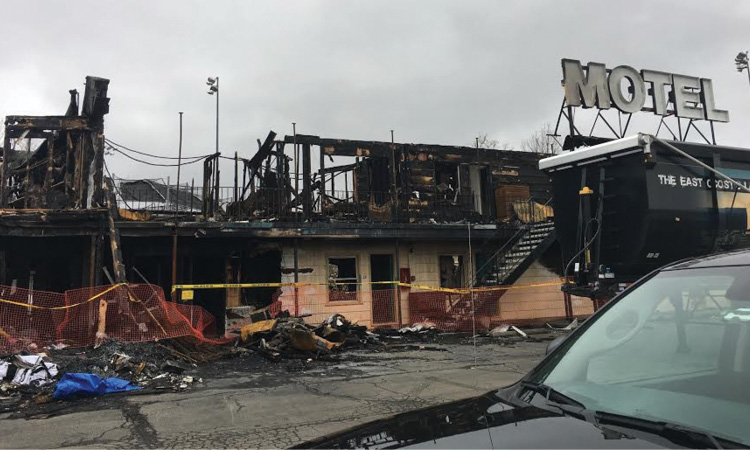
(1) One person died in this overnight fire in a motel in Vestal, New York. The fire was caused by an electric space heater. (Photos by author.)
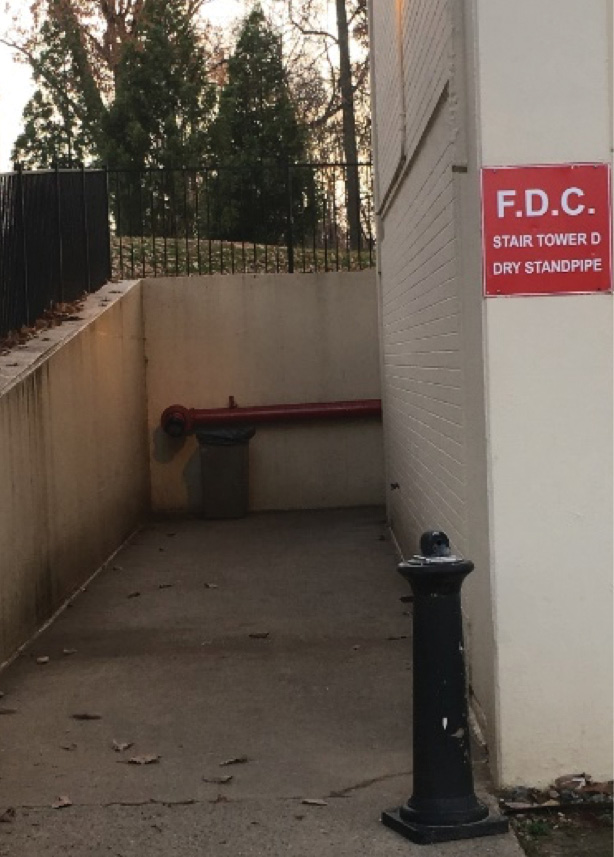
(2) Some fire department connections serve only a portion of the building.

(3) The Double Tree® by Hilton Hotel, King of Prussia, Pennsylvania.
What’s the Difference?
As noted, there are differences between motels and hotels, and there are also some similarities. From a firefighting standpoint, strategies and tactics in low- and mid-rise motels are similar to those used in garden apartments and condo complexes. Fires in high-rise hotels are similar to fires in residential high- and mid-rises and dormitories. Your preplans should include what types of protection systems are in the occupancy.
Both hotels and motels have some level of fire protection. Hotels are more likely to be equipped with standpipes, pump rooms, and sprinklers in each room. Thanks to the Hotel and Motel Fire Safety Act of 1990, which was one result of numerous tragic hotel fires that resulted in multiple fatalities, today’s hotels offer more fire protection.
Hotels
Hotel comes from a French word for an establishment that provides lodging, meals, and other services. Hotels usually have traction elevators, escalators, balconies, parking garages, and rooms that open to the building’s interior hallway. They offer more amenities, such as fitness centers, room service, suites, stores, restaurants, salons, casinos, cocktail lounges, bellhops, valet parking, and banquet facilities, than motels. Some examples of hotels are Holiday Inn, Marriott, Four Seasons, Hyatt, Radisson, and Westin.
Hotels are usually fire-resistive or noncombustible mid-rises or high-rises equipped with numerous protection systems. Although hotels have protection systems, they also contain combustible furnishings.
On approach, when preparing for apparatus placement, keep in mind that the fire department connection and signage may be obstructed by bushes and trees. Do not risk driving under low canopies that can damage the apparatus. During size-up, notice any adjacent and attached areas such as parking garages, restaurants, and catering halls with events taking place. Check wind conditions and wind direction for potential wind-driven fires. In addition, look for balconies for ventilation (breaking glass) and aerial placement options.
For fires originating in guest rooms in fire-resistive high-rise hotels, strategy and tactics will be similar to those at residential high-rise apartment fires. Other fires may occur in utility rooms, laundry facilities, adjacent occupancies, and underground parking facilities or on the exterior involving combustible exterior insulation and finish system (EIFS) or decorative pieces of polystyrene attached to the facade. This occurred at the 32-story Monte Carlo Hotel in Las Vegas (https://youtu.be/JC0TB8Hafys).
Motels
Motels came along much later, in 1925. Motel is a blend of the words “motor” and “hotel.” They provide some services offered by hotels. These occupancies are usually one- to two-story low-rises. Older motels have exterior doors to the rooms that face the parking lot, a courtyard, or a common area. Motels usually have hydraulic elevators, exterior stairways, narrow exterior corridors, rear balconies, and breezeways. The layout of most motels is typically constructed in an “I-,” “L-,” or a “U”-shaped layout.
Motels offer fewer amenities, have fewer employees, and are less expensive than hotels. They are often located near airports, urban areas, attractions, freeways, and the outskirts of town where hotels are not present. Beach and coastal regions (New Jersey, Maryland, Virginia, South Carolina, Florida) have hundreds of one- to three-story motels. Some examples of motels are Econo Lodge, Motel 6, Knights Inn, and Super 8, to name a few.
The motel is a unique occupancy type that necessitates different firefighting strategy and tactics compared to a fire in a fire-resistive high-rise hotel. Fires in motels of wood-frame construction grow and intensify extremely quickly. A fire in an average-sized motel room can consume everything in the room in less than five minutes. Motels with combustible construction, especially lightweight trusses, are often a total loss.
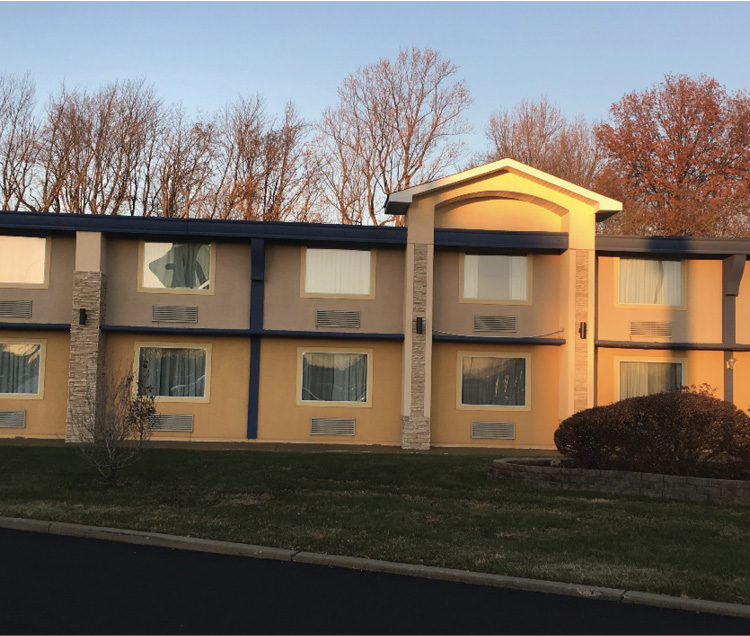
(4) Send a company to the rear of these two-story motels to check for “jumpers” who may have escaped through sliding-glass windows.
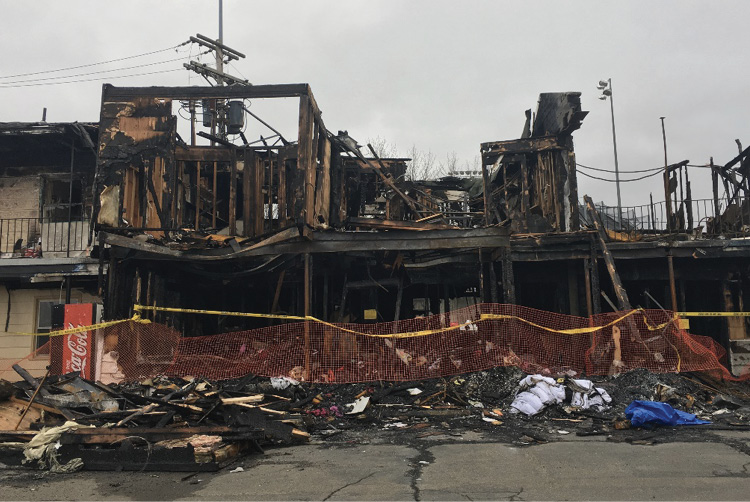
(5) Two-story wood-frame motels have numerous voids that contribute to rapid fire spread.

(6) On arrival, check to see if a motel employee is present. Attempt to get a master key card to access numerous rooms more quickly than by forcing entry.
Most motel rooms have smoke detectors, but they lack sprinklers, which may be in common areas, corridors, hallways, and lobbies instead of in individual guest rooms.
A five-alarm fire in Houston, Texas, at the Southwest Inn killed five Houston firefighters. Captain William Dowling was injured in the collapse and lost both legs and suffered a brain injury. He died on March 7, 2017, from complications from his injuries, becoming the fifth firefighter to be killed in that tragic fire (http://www.khou.com/news/community/family-asks-for-prayers-for-iron-bill-dowling/420532038). The Southwest Inn fire burned for three hours in an attic above the kitchen before it was discovered. High winds fueled the fire, and the structure collapsed approximately 12 minutes after the first companies arrived, according to the National Institute for Occupational Safety and Health line-of-duty-death report (https://www.cdc.gov/niosh/fire/pdfs/face201316.pdf).
Size-Up
When it comes to motel fires, first-arriving companies need to quickly address life hazards, construction, forcible entry issues, ladder placement, and ventilation concerns. Stretching initial attack lines will be difficult, but you have to stretch them quickly. Motel fires will necessitate additional personnel for forcible entry, evacuation of adjoining rooms, and roof ventilation, if needed. How many doors are facing the parking lot and courtyard in a motel? How do you know which rooms are occupied? You really don’t.
Construction
Construction will vary, but most will be of type 2, 3, or 5 with lightweight truss construction and EIFS in hotels with modern constructon. Currently, many new hotels, motels, and residential apartment buildings are built using five-story wood-frame “podium” (platform) construction. This saves the builder additional costs in fire protection because the structure is not considered a high-rise.
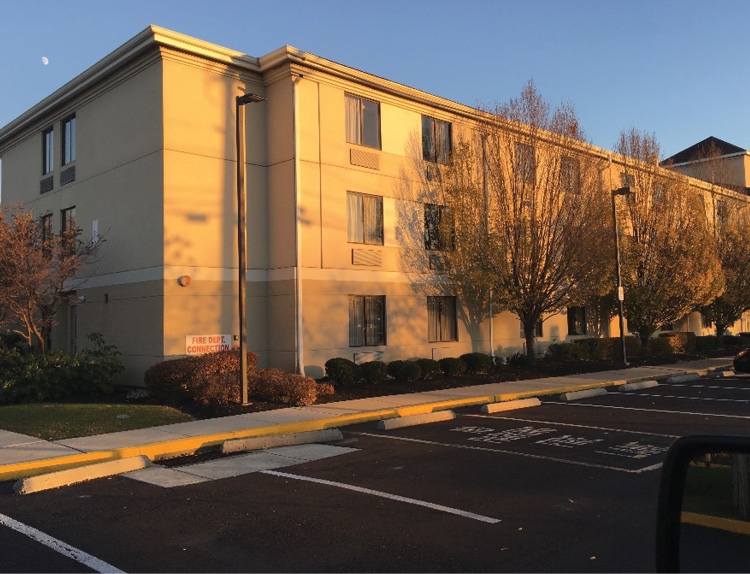
(7) You don’t always have to use the standpipe in these buildings. If the fire is on the first or second floor and a stairwell access door is in proximity, it may be better to stretch a preconnect if possible.
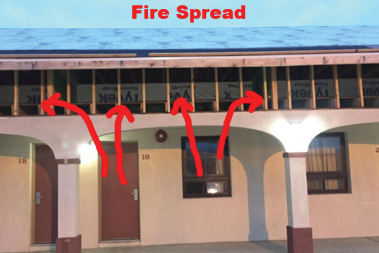
(8) One-story motel fires will spread right to left. If these fires progress past the room-and-contents phase, the roof may have to be opened.

(9) Place ground ladders for occupants in rooms cut off by the fire and those who can’t make the exterior stairs.
In the 2014 Mariner’s Cove Motel fire in Point Pleasant, New Jersey, four people perished. Security video footage released by the Ocean County Prosecutor’s Office shows that a man, who died in the fire, reportedly was smoking in a second-floor, wood-paneled common area of the motel. After the man left the area, a cigarette ash smoldering in a cushion ignited after 90 minutes. The fire progressed in minutes and destroyed the motel (https://youtu.be/HsO9anDX1wPOINT) (https://www.app.com/story/news/crime/jersey-mayhem/2014/07/02/mariners-cove-fire/12042571/).
Fire Spread
Most motel fires occur in the guest rooms, which have one door for access and egress (some interior doors may be present for adjoining rooms). If the main door to the room is left open or if fire is venting out of a window on arrival, the fire will run up the soffit and spread vertically and horizontally. A second- or third-story room fire will run up the soffit and spread into the cockloft. On arrival, look for overhangs and check adjoining rooms and the cockloft for hidden fire.
Consider fire spread concerns in a small three-story, wood-frame motel with 10 rooms on each floor having more than 30 toilets, bathtubs, sinks, vents, and so on. The void space from electric, cable, plumbing in each room, and the laundry areas will provide many holes that will allow the fire to spread quickly. Wind is a major factor in fire spread in coastal areas where beachfront motels are common.
Many newer motels are built of lightweight wood-frame construction with truss roofs and polystyrene exterior insulation. If the buildings are fully clad with EIFS, that will contribute to rapid fire spread. Identify these features on fire preplans.
Search and Rescue
During motel fires, start rescue/evacuation by alerting adjoining rooms closest to the fire on both sides, and place ground ladders in the front and the rear. Occupants may be cut off from the exterior stairwells, which may be their only escape routes. Check the rear for jumpers and consider using 24-foot ground ladders for quick placement.
Depending on how full the parking lot is and if the motel is higher than three stories, set up aerial ladders on the corners to access two sides of the building for rescue and roof ventilation. Immediately bang on doors and open unlocked doors to check for occupants closest to the fire.
Many motels have parking spaces numbered for each room. Vehicles parked in front of these rooms are likely to be occupied, but do not assume that no one is in that room because no vehicle is in that space. Quickly conduct a primary search of the rooms, sweeping under the beds and looking in the closets and in the bathrooms, where kids are likely to hide. Some residents may refuse to leave, believing there’s a false alarm or for some other reason. Have police remove them if possible. Sometimes, children may be alone in motel rooms and are too scared to answer a door on which firefighters are banging in the middle of the night. During a fire, kids tend to hide under beds, in closets, and in bathtubs. Toys and bicycles are indicators that children are present. Open and search these rooms quickly.
Rapid Intervention
The rapid intervention team (RIT) or firefighter assist and search team (FAST) should never be one size fits all. Consider assigning a proactive RIT/FAST and putting the members to work during these fires instead of having them on standby in the street or parking lot waiting for a Mayday to be called. Primary searches of motel guest rooms are less dangerous for firefighters than other occupancies as the firefighters will not have to venture so deep into the maze of a structure. If staffing is an issue, the RIT/FAST can assist with forcible entry, ground ladder placement, and searches of numerous rooms while monitoring the radio for emergency traffic.
Forcible Entry
Motels have inward-swinging entrance doors. Many of the modern motels have key card access and more fortified locking mechanisms, which may necessitate the hydraulic spreading tool. Hopefully, firefighters banging on doors will alert the occupants. Imagine the personnel needed if you have to force numerous doors at a fully occupied three-story motel with heavy fire conditions in the middle of the night. As a last resort, take out the windows and clear them for vent-enter-search. Keep in mind that many motel windows are difficult to break. Consider rescue priorities, property damage, and fire spread potential when deciding whether to break a pitch-glass window.
Note: Some seedy motels house drug users who may be under the influence of alcohol or drugs when firefighters are banging on the door alerting them to the fire. They might not hear the warnings. Some of these people may be permanently housed in motels through programs, charities, rehab, release programs, and the like.
Fire Attack
Quickly get water on the fire. The first-due fire attack team must deploy lines quickly. You cannot delay when heavy fire is showing from a wood-frame motel room, or the building will be a total loss. Also, if the motel occupants’ egress routes are blocked by fire, the initial line must protect their escape route.
Tank water is not carried on the apparatus to make it heavier. The purpose of filling the tank with 500 to 750 gallons of water is to extinguish fire, not for a backup plan. Properly placing a few hundred gallons of water on a well-involved compartment fire is better than a master stream breaking in the wind from a hundred feet away, several minutes later. We’ve seen this nonaggressive bad tactic performed way too often.
The first-due engine hunting for a hydrant and forward laying a supply line into the motel lot will waste precious time. Consider using tank water. A pumper with 500 to 750 gallons of tank water is enough to knock down several rooms of fire if the nozzleman is aggressive. Depending on apparatus and personnel, consider using two pumpers for the initial attack when using tank water. Two pumpers can put more than 1,000 gallons of water on the fire. Remember, a well-involved guest room in a three-tier wood-frame motel will take over the building if you do not control it quickly.
You can handle a small room-and-contents fire within a few hundred feet of the engine with a 185-gallon-per-minute (gpm) 1¾-inch line. Heavy fire exiting the windows or doors on arrival will demand a minimum 200- to 250-gpm 2½-inch line. Delayed discovery and long response times may result in having two or more rooms with heavy fire showing on arrival; in this case, you may have to use a 2½-inch line or consider setting up master streams. Prepare to stretch lines to rooms remote from the parking lot (courtyard areas), which may necessitate a longer stretch from the pumper than the preconnects can reach.
Ventilation
Depending on whether there are fire walls, a fast-moving fire may necessitate a trench cut when fire reaches the cockloft and is spreading quickly. Unless a window fails during the fire, the front door may be the only way to horizontally ventilate in nontop-floor motel guest rooms, as some windows are difficult to break. Coordinate this effort with the fire attack team’s quickly applying water to prevent fire from exiting the room and spreading vertically.
Motel fires are not rare occurrences. Most motels are wood-frame construction and offer less fire protection than hotels. Fires in fire-resistive high-rise and noncombustible hotels may allow for confinement and extinguishment with long reflex times, but burning motels will not. If you do not apply water to the fire within several minutes, the fire will consume the entire building. It’s important to preplan the motels in your response area.
Brian Butler is a captain in Trenton, New Jersey, where he has served for 22 years. He worked for 15 years on an engine company and for seven years on a ladder company. He is a member of the King of Prussia (PA) Fire Rescue and the Bucks County (PA) Hazmat Team and a rescue technician with the Southeastern (PA) Regional Technical Rescue Task Force. He is a Level 2 fire instructor. Butler is the owner of UrbanFireTraining.com.

